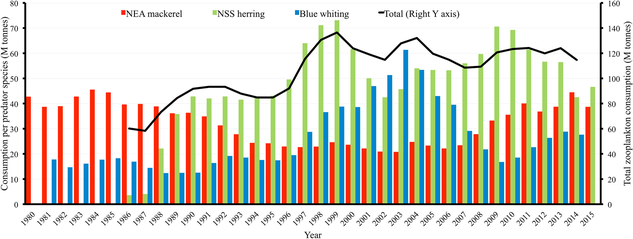
Figure 2. Total zooplankton consumption by NEA mackerel, NSS herring and blue whiting, from 1980 to 2015. Estimates are based on the mean consumption values from 2005–2010, which were then extrapolated to the total fish biomass reported for different years by the assessment [9]. Black line represents the total consumption by the three species (note the different scale on the right vertical axis).
Study on the consumption of zooplankton by pelagic fish in the Northeast Atlantic ocean
In their study entitled “Bioenergetics modeling of the annual consumption of zooplankton by pelagic fish feeding in the Northeast Atlantic”, Eneko Bachiller, Kjell Rong Utne and Teunis Jansen, all EcoNorSe project participants, along with Geir Huse (IMR), modeled the consumption in the Norwegian Sea, which is the main feeding ground for the three main small pelagic fish stocks in the Northeast Atlantic (NEA).
These stocks are: Norwegian Spring Spawning (NSS) herring and blue whiting (in spring and summer) and NEA mackerel (in summer). The increasing spatial overlap between NSS herring and NEA mackerel in recent years could potentially increase their inter-specific competition. In fact, NEA mackerel still seems to be feeding effectively, as suggested by their higher feeding efficiency and stomach fullness indices contrasting earlier periods with limited spatial overlap with NSS herring.
Based on the data obtained from scientific surveys in the main feeding area in the period 2005–2010, and incorporating novel information about ambient temperature, seasonal growth and changes in the diet from stomach content analyses (Bachiller et al. 2016), this study uses bioenergetics modelling to estimate the annual consumption of the main zooplankton groups by pelagic fish. Results show higher consumption estimates than previous studies for the three species, suggesting that fish might now have a greater impact on the zooplankton community as foragers.

Figure 1. Annual (2005–2010) prey consumption estimates for NEA mackerel, NSS herring and blue whiting.
This way, NEA mackerel (with the highest daily consumption rates) and NSS herring, annually consume around 10 times their total biomass, whereas blue whiting consume about 6 times their biomass in zooplankton. Therefore, the three species are estimated to consume an average of 135 million (M) tonnes of zooplankton each year, consisting of 53–85 M tonnes of copepods, 20–32 M tonnes of krill, 8–42 M tonnes of appendicularians and 0.2–1.2 M tonnes of fish, depending on the year.
Results suggest high potential for inter-specific feeding competition between NSS herring and NEA mackerel, and low interaction with blue whiting, which show lower consumption rates and a diet mainly based on larger euphausiids. Accordingly, the species might have niche segregation, as they are species specific, showing annual and inter-annual variability in total consumption of the different prey species. The three species can therefore coexist regardless of their high abundance, zooplankton consumption rates and overlapping diets, at least if the available total zooplankton remains high enough to avoid negative effects due to inter-specific feeding competition.
The full research article is available in this link.
